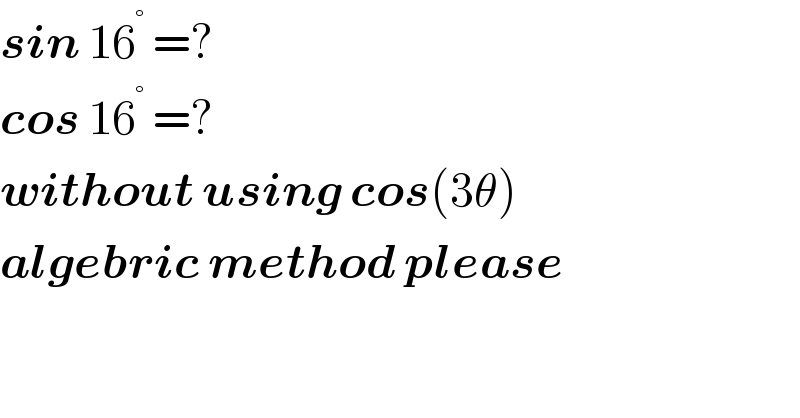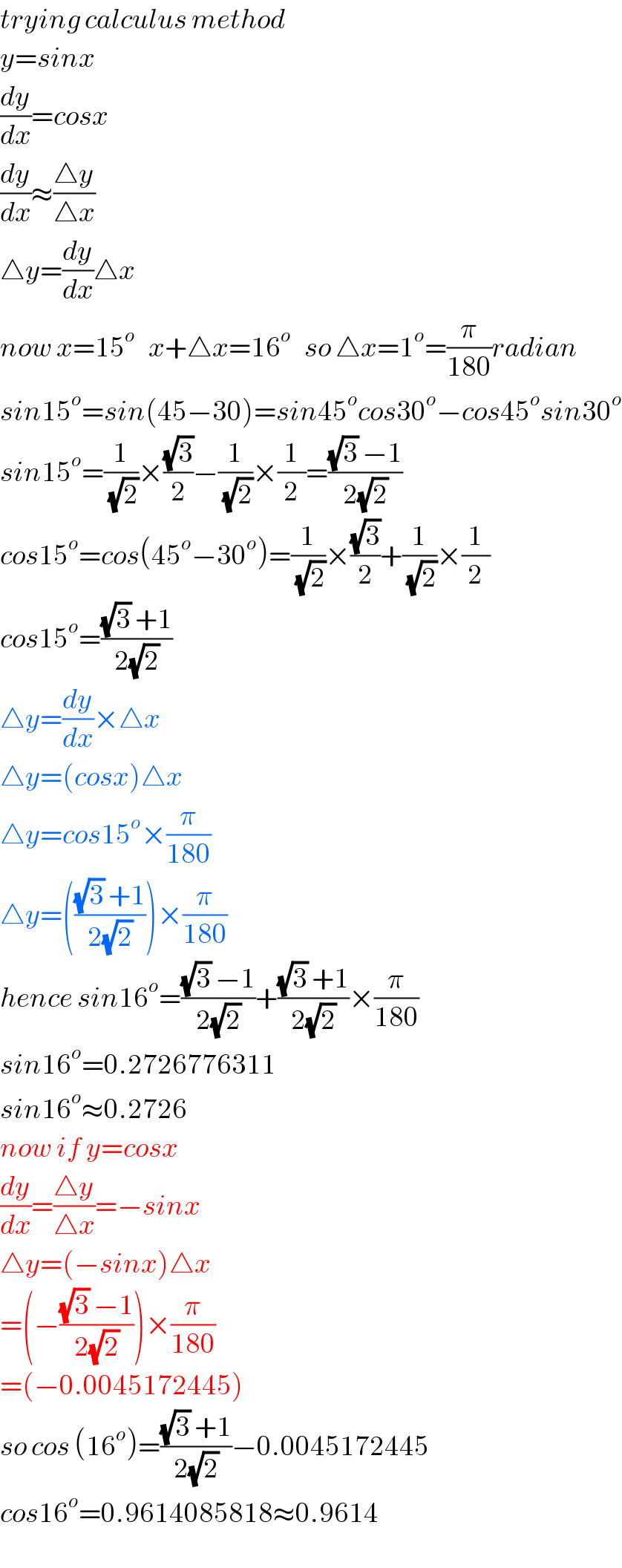Question Number 58521 by malwaan last updated on 24/Apr/19

$$\boldsymbol{{sin}}\:\mathrm{16}^{°} \:=? \\ $$$$\boldsymbol{{cos}}\:\mathrm{16}^{°} \:=? \\ $$$$\boldsymbol{{without}}\:\boldsymbol{{using}}\:\boldsymbol{{cos}}\left(\mathrm{3}\theta\right) \\ $$$$\boldsymbol{{algebric}}\:\boldsymbol{{method}}\:\boldsymbol{{please}} \\ $$
Answered by tanmay last updated on 24/Apr/19

$${trying}\:{calculus}\:{method} \\ $$$${y}={sinx} \\ $$$$\frac{{dy}}{{dx}}={cosx} \\ $$$$\frac{{dy}}{{dx}}\approx\frac{\bigtriangleup{y}}{\bigtriangleup{x}} \\ $$$$\bigtriangleup{y}=\frac{{dy}}{{dx}}\bigtriangleup{x} \\ $$$${now}\:{x}=\mathrm{15}^{{o}} \:\:\:{x}+\bigtriangleup{x}=\mathrm{16}^{{o}} \:\:\:{so}\:\bigtriangleup{x}=\mathrm{1}^{{o}} =\frac{\pi}{\mathrm{180}}{radian} \\ $$$${sin}\mathrm{15}^{{o}} ={sin}\left(\mathrm{45}−\mathrm{30}\right)={sin}\mathrm{45}^{{o}} {cos}\mathrm{30}^{{o}} −{cos}\mathrm{45}^{{o}} {sin}\mathrm{30}^{{o}} \\ $$$${sin}\mathrm{15}^{{o}} =\frac{\mathrm{1}}{\:\sqrt{\mathrm{2}}}×\frac{\sqrt{\mathrm{3}}}{\mathrm{2}}−\frac{\mathrm{1}}{\:\sqrt{\mathrm{2}}}×\frac{\mathrm{1}}{\mathrm{2}}=\frac{\sqrt{\mathrm{3}}\:−\mathrm{1}}{\mathrm{2}\sqrt{\mathrm{2}}} \\ $$$${cos}\mathrm{15}^{{o}} ={cos}\left(\mathrm{45}^{{o}} −\mathrm{30}^{{o}} \right)=\frac{\mathrm{1}}{\:\sqrt{\mathrm{2}}}×\frac{\sqrt{\mathrm{3}}}{\mathrm{2}}+\frac{\mathrm{1}}{\:\sqrt{\mathrm{2}}}×\frac{\mathrm{1}}{\mathrm{2}} \\ $$$${cos}\mathrm{15}^{{o}} =\frac{\sqrt{\mathrm{3}}\:+\mathrm{1}}{\mathrm{2}\sqrt{\mathrm{2}}} \\ $$$$\bigtriangleup{y}=\frac{{dy}}{{dx}}×\bigtriangleup{x} \\ $$$$\bigtriangleup{y}=\left({cosx}\right)\bigtriangleup{x} \\ $$$$\bigtriangleup{y}={cos}\mathrm{15}^{{o}} ×\frac{\pi}{\mathrm{180}} \\ $$$$\bigtriangleup{y}=\left(\frac{\sqrt{\mathrm{3}}\:+\mathrm{1}}{\mathrm{2}\sqrt{\mathrm{2}}}\right)×\frac{\pi}{\mathrm{180}} \\ $$$${hence}\:{sin}\mathrm{16}^{{o}} =\frac{\sqrt{\mathrm{3}}\:−\mathrm{1}}{\mathrm{2}\sqrt{\mathrm{2}}}+\frac{\sqrt{\mathrm{3}}\:+\mathrm{1}}{\mathrm{2}\sqrt{\mathrm{2}}}×\frac{\pi}{\mathrm{180}} \\ $$$${sin}\mathrm{16}^{{o}} =\mathrm{0}.\mathrm{2726776311} \\ $$$${sin}\mathrm{16}^{{o}} \approx\mathrm{0}.\mathrm{2726} \\ $$$${now}\:{if}\:{y}={cosx} \\ $$$$\frac{{dy}}{{dx}}=\frac{\bigtriangleup{y}}{\bigtriangleup{x}}=−{sinx} \\ $$$$\bigtriangleup{y}=\left(−{sinx}\right)\bigtriangleup{x} \\ $$$$=\left(−\frac{\sqrt{\mathrm{3}}\:−\mathrm{1}}{\mathrm{2}\sqrt{\mathrm{2}}}\right)×\frac{\pi}{\mathrm{180}} \\ $$$$=\left(−\mathrm{0}.\mathrm{0045172445}\right) \\ $$$${so}\:{cos}\:\left(\mathrm{16}^{{o}} \right)=\frac{\sqrt{\mathrm{3}}\:+\mathrm{1}}{\mathrm{2}\sqrt{\mathrm{2}}}−\mathrm{0}.\mathrm{0045172445} \\ $$$${cos}\mathrm{16}^{{o}} =\mathrm{0}.\mathrm{9614085818}\approx\mathrm{0}.\mathrm{9614} \\ $$
Commented by malwaan last updated on 25/Apr/19

$${thank}\:{you}\:{so}\:{much}\:{sir} \\ $$
